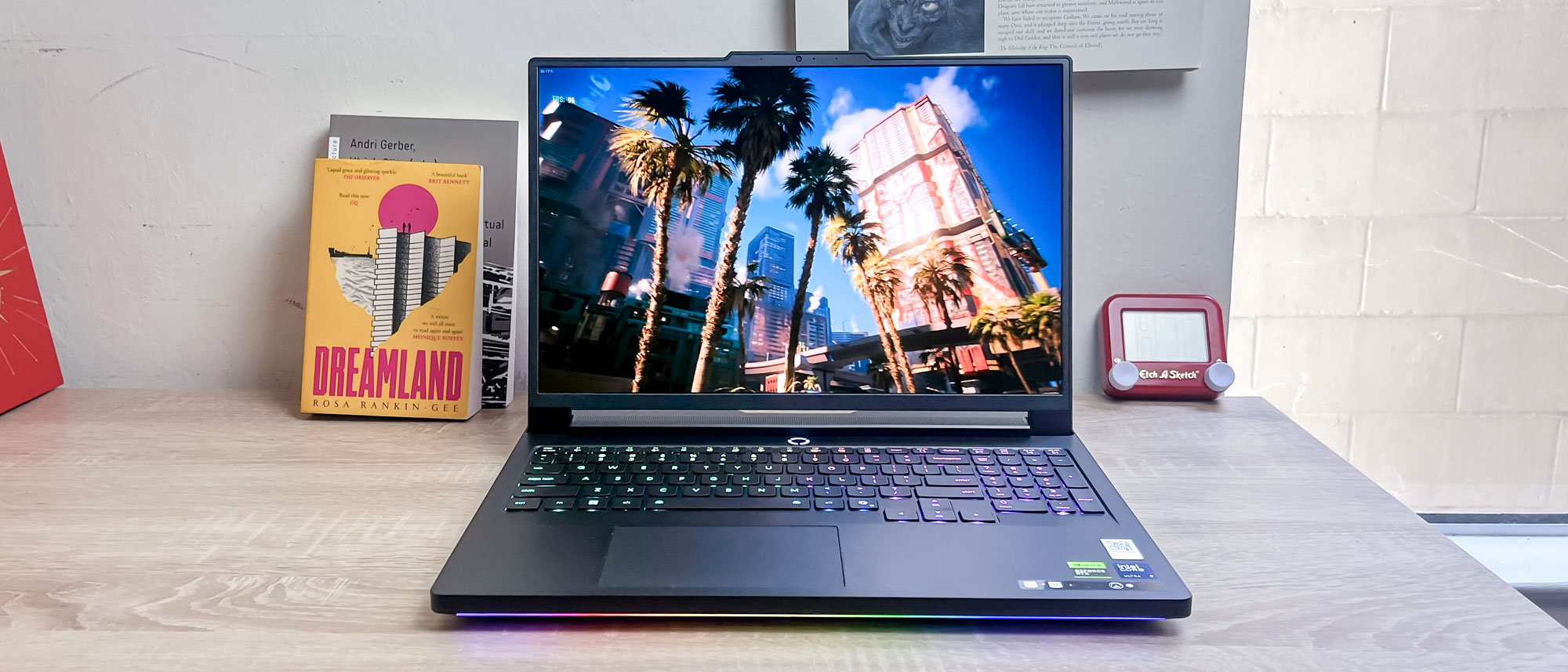Tom's Guide Verdict
The 10th Gen Lenovo Legion Pro 7i takes the company's 16-inch gaming laptop line to new heights thanks to the power of Nvidia's RTX 50-series GPUs. The 240Hz OLED display makes everything you do on it look great, and when you factor in the elegant design and plentiful port array you see why I think this is one of the best gaming laptops of 2025 so far.
Pros
- +
Gorgeous OLED display
- +
Killer gaming performance
- +
Elegant, sleek design
- +
Plenty of ports
Cons
- -
Expensive (like most gaming laptops)
- -
Heavy (like most gaming laptops)
Why you can trust Tom's Guide
The 2025 edition of the Lenovo Legion Pro 7i ($2,849 to start) takes this 16-inch gaming laptop to new heights thanks to the power of Nvidia's RTX 50-series laptop GPUs.
Though it's not cheap, I think this 10th edition of the Legion Pro 7i justifies its high price with a one-two punch of killer performance and a gorgeous 16-inch 240Hz OLED display.
Factor in the sleek, eye-catching design and plentiful port array and you start to see why I think this is one of the best gaming laptops I've reviewed in years. It's also my first opportunity to really put Nvidia's RTX 50-series GPUs to the test in daily use, and I gotta tell you — this is also the most fun I've had reviewing a laptop in years.
To explain why, let me walk you through what I love (and don't) about this beastly machine in my Lenovo Legion Pro 7i review.
Lenovo Legion Pro 7i review: Cheat sheet
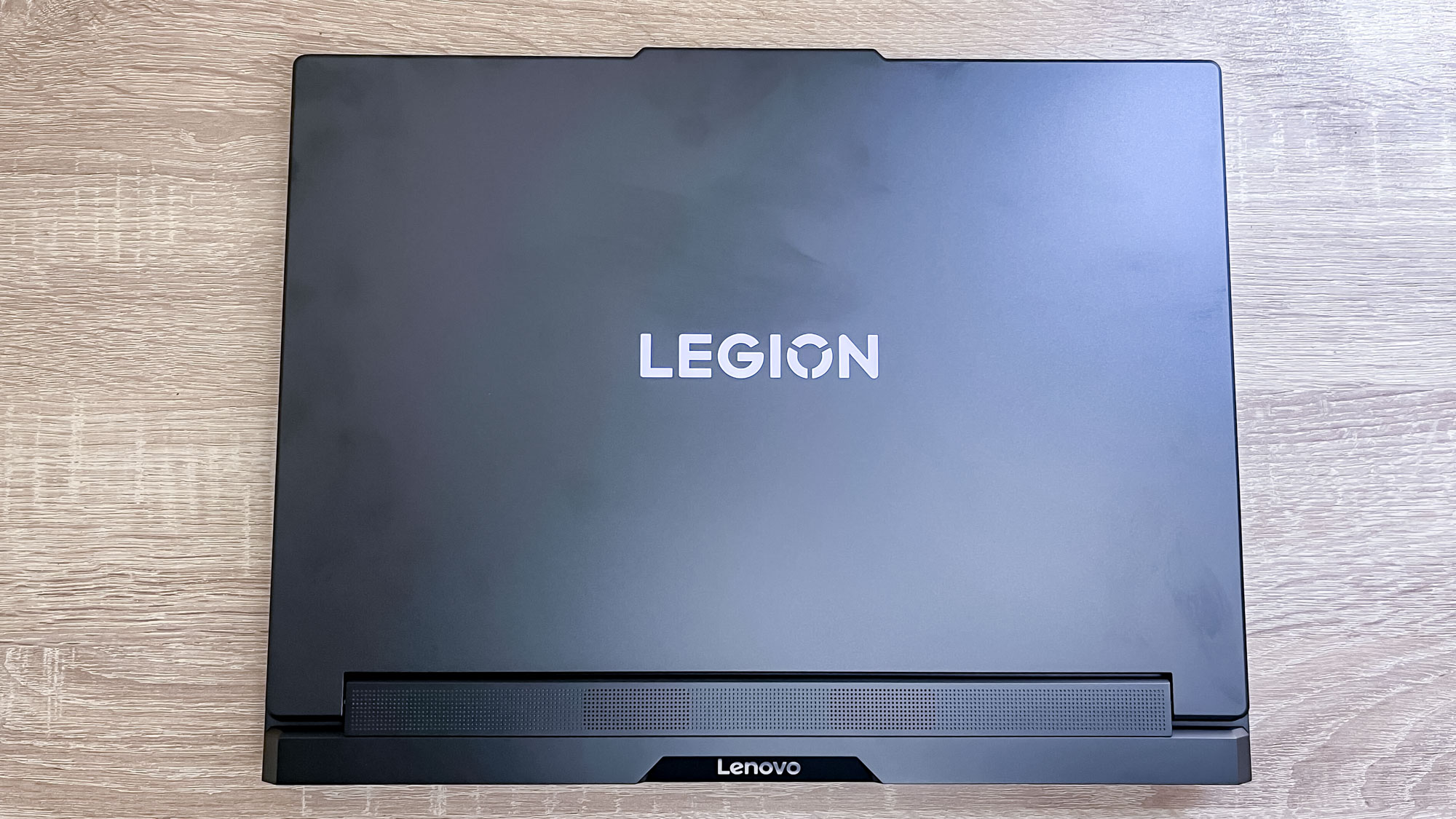
- What is it? The 2025 edition of Lenovo's premier 16-inch gaming laptop, now with the latest Nvidia GeForce RTX 50-series laptop GPUs onboard.
- Who is it for? Those who want a 16-inch OLED gaming laptop with enough power to match most gaming desktops, and are willing to pay for the privilege.
- What does it cost? The 2025 Lenovo Legion 5i starts at around $2,849, but the model I review here can be purchased directly from B&H for $3,499.
- What's good about it? The luscious 1600p 240Hz OLED display and incredible gaming power make this a great gaming laptop, and the elegant design makes it easy on the eyes and a joy to work on.
- What's not so good? The price and weight are a little too high for comfort, while the battery life is a little too low for my tastes. But then, that's par for the course with these kinds of laptops.
Lenovo Legion Pro 7i review: Specs
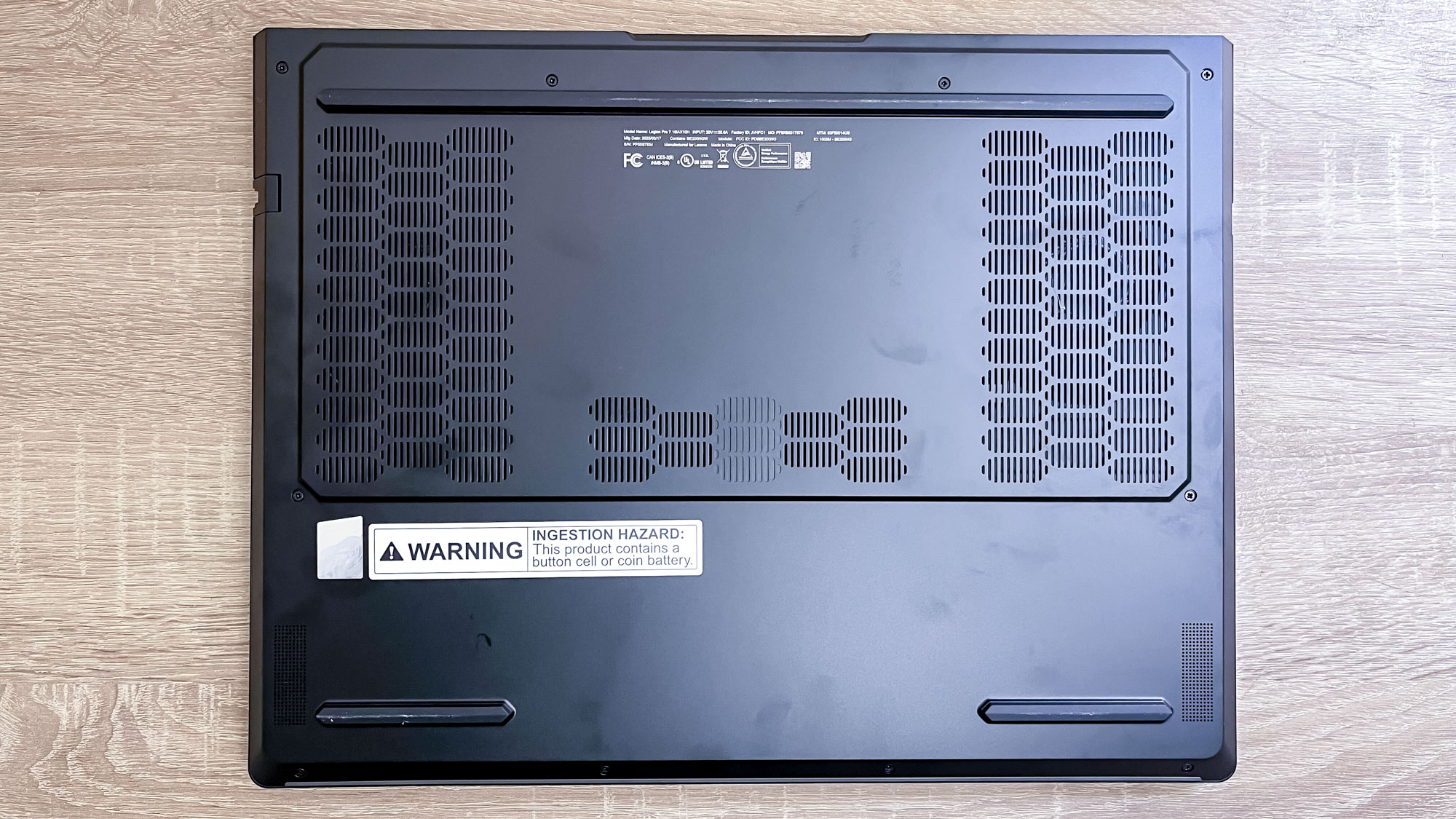
| Row 0 - Cell 0 | Lenovo Legion Pro 7i (starting) | Lenovo Legion Pro 7i (as tested) |
Price | $2,849 | $3,499 |
Display | 16-inch (2560 x 1600) 240Hz OLED | 16-inch (2560 x 1600) 240Hz OLED |
CPU | Intel Core Ultra 9 275HX | Intel Core Ultra 9 275HX |
GPU | NVIDIA GeForce RTX 5070 Ti | NVIDIA GeForce RTX 5080 |
Memory | 32GB | 32GB |
Storage | 2TB SSD | 2TB SSD |
Ports | 1x Thunderbolt 4, 1x USB-C, 3x USB-A, 1x HDMI 2.1, RJ-45, audio jack | 1x Thunderbolt 4, 1x USB-C, 3x USB-A, 1x HDMI 2.1, RJ-45, audio jack |
Size | 14.35 x 10.86 x 1.05 inches | 14.35 x 10.86 x 1.05 inches |
Weight | 5.98 lbs | 5.98 lbs |
Lenovo Legion Pro 7i review: The ups
This is the most attractive and performant gaming laptop I've ever reviewed, and there are some specific strengths I want to call out if you're on the fence about buying one.
Gorgeous (and color-accurate) OLED display
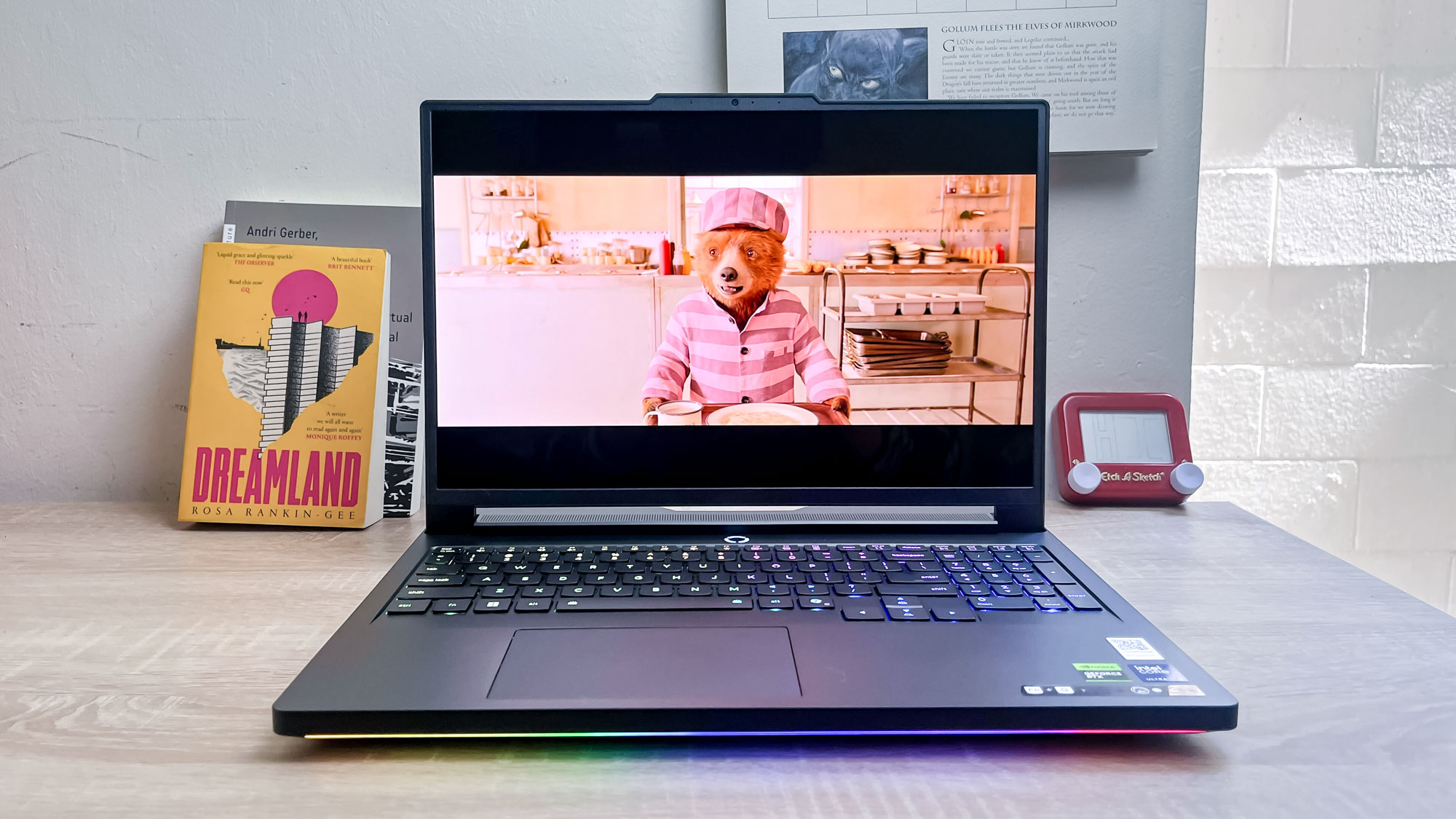
I love the 16-inch OLED display on our Lenovo Legion Pro 7i review unit.
Admittedly, I'm a bit of a mark for OLED displays because I love the bright whites, inky blacks and sharp contrasts that seem to pop off an OLED panel. Having one really does make everything you do on it look better, and when gaming with HDR enabled and Dolby Vision in effect I really love how good everything looks on the Legion Pro 7i.
While I spent much of my time with this laptop hooking it up to an OLED TV for 4K gaming, every time I switched back to the built-in display I was impressed by how bright and colorful it gets.
Heck, I cracked the lid of this laptop open just a smidge early this morning to finish this review, and the light spilling out from the screen at even half brightness filled my dark living room and then some. It was like I was opening the briefcase in Pulp Fiction, except I knew what awaited me inside—gorgeous graphics.
| Row 0 - Cell 0 | Lenovo Legion Pro 7i | Asus ROG Strix Scar 16 | HP Omen Max 16 |
Average brightness (nits) | 464.4 | 429.4 | 362.8 |
sRGB gamut | 196% | 114.7% | 199.7% |
DCI-P3 gamut | 138.9% | 81.2% | 141.4% |
When we got our review unit into the testing lab, I was even more impressed at how well it performed. As you can see from the chart of results above, this thing gets pretty bright, with an average brightness of 464.4 nits that can climb all the way up to 1,000+ nits when viewing HDR content.
But what really surprises me is that this screen manages to cover over 100% of both the sRGB and the more demanding DCI-P3 color gamuts.
I've been reviewing high-end laptops here at Tom's Guide for years and I almost never see a laptop with a screen capable of achieving 100% of both of these color gamuts, so it's amazing to see that not only does this Lenovo Legion Pro 7i achieve that, so too does another 16-inch OLED-equipped gaming laptop we're currently testing—the 2025 HP Omen Max 16.
Of course, our Lenovo Legion Pro 7i gets brighter than the HP Omen Max 16 and appears to be more color-accurate, since it has a slightly lower Delta-E score.
These aren't the first laptops to have a screen this colorful, but it's pretty rare and is typically limited to high-end creator laptops which are intended for serious photo/video/animation work.
Admittedly, you probably won't notice a practical benefit to this performance unless you're doing that kind of work where color accuracy is key, but it's still amazing to see on a Lenovo gaming laptop and I wanted to shout it out.
Next-gen gaming performance

As you might expect from the spec list, the Intel Core Ultra 9 275HX CPU and Nvidia GeForce RTX 5080 laptop GPU give this portable PC more than enough horsepower to run even the best PC games at 60+ frames per second at native resolution—if you're using Nvidia's DLSS upscaling tech.
This is the first gaming laptop I've ever reviewed that feels like it could be a bona fide desktop gaming PC replacement.
Even without DLSS you can still get good performance in many games at native resolution on our Legion Pro 7i review unit, but for top-tier framerates in demanding games like Cyberpunk 2077 you're going to want to turn on DLSS and fine-tune the settings.
Since it has a GeForce RTX 50-series GPU on board, this laptop supports all the latest features of DLSS 4, including multi-frame generation.
I was initially skeptical of this feature (which inserts up to 3 AI-generated frames between "real" frames of gameplay to boost framerate) when I saw it during press demos, but now that I've had a chance to try it myself in a few games I have to admit it works well and didn't cause me any noticeable graphical issues or input latency.
| Row 0 - Cell 0 | Lenovo Legion Pro 7i (RTX 5080) | Asus ROG Strix Scar 16 (RTX 5090) | HP Omen Max 16 (RTX 5090) |
Assassin's Creed Shadows (Ultra High) | 45 | 47 | 49 |
Black Myth: Wukong (Cinematic) | 45 | 62 | 51 |
Cyberpunk 2077 | 50.2 | 61.1 | 58.04 |
As you can see from our chart of test results above, the Lenovo Legion Pro 7i is no slouch when it comes to gaming performance in our testing lab.
These FPS scores are all recorded in 1080p with no upscaling tech (like DLSS) enabled so we can compare them across different laptops, so don't take these as gospel for what you'll get when gaming on your own. Thanks to DLSS 4 I've had this thing running Cyberpunk 2077 at 4K on maximum graphical settings reliably hitting 70+ FPS all week, and I've yet to see it stutter.
Now since we're just reviewing our first wave of RTX 50-series gaming laptops I don't have a ton of machines to compare it against yet, so I've stacked the Legion Pro 7i's performance up against two recently-tested 16-inch RTX 5090 machines: the HP Omen Max and the Asus ROG Strix 16.
And while both outpace our Lenovo Legion Pro 7i review unit in raw performance, that's to be expected given they both come with a more powerful RTX 5090 laptop GPU onboard. Otherwise these laptops are awfully similar (16-inch 1600p gaming laptops with an Intel Core Ultra 9 275HX CPU and 32GB of RAM), which can help you understand the difference going with RTX 5080 over RTX 5090.
In fact, this is the first gaming laptop I've ever reviewed that feels like it could be a bona fide desktop gaming PC replacement.
I've had it on my coffee table hooked up to my LG C2 OLED for some 4K gaming on the couch all week, and even at 4K this beast makes almost zero noise kicking out 60+ frames per second in games like Cyberpunk 2077 and Star Wars Outlaws—again, as long as you have DLSS enabled!
Elegant, sleek design

Our Lenovo Legion Pro 7i review unit is a hefty beast at nearly six pounds, but it doesn't look like it. Every time I picked up this machine I was surprised something that looks so sleek and elegant could feel so heavy, which tells me Lenovo is doing something right with this design.
Other things I love about this laptop's design include the easy-open lip on the top lid of the laptop, the smart and intuitive function keys (I love the way you can hit the Fn key and see all the relevant key combos light up on the keyboard), the 1.8mm key travel on the TrueStrike keyboard and the side-mounted privacy shutter switch that disables the webcam when you want privacy.
For all these reasons and more, I think the Lenovo Legion Pro 7i is an elegant, well-designed machine that circumvents a lot of the stumbling blocks (like garish emblems and way-too-edgy designs) that tend to trip up other gaming laptops.
Plenty of ports
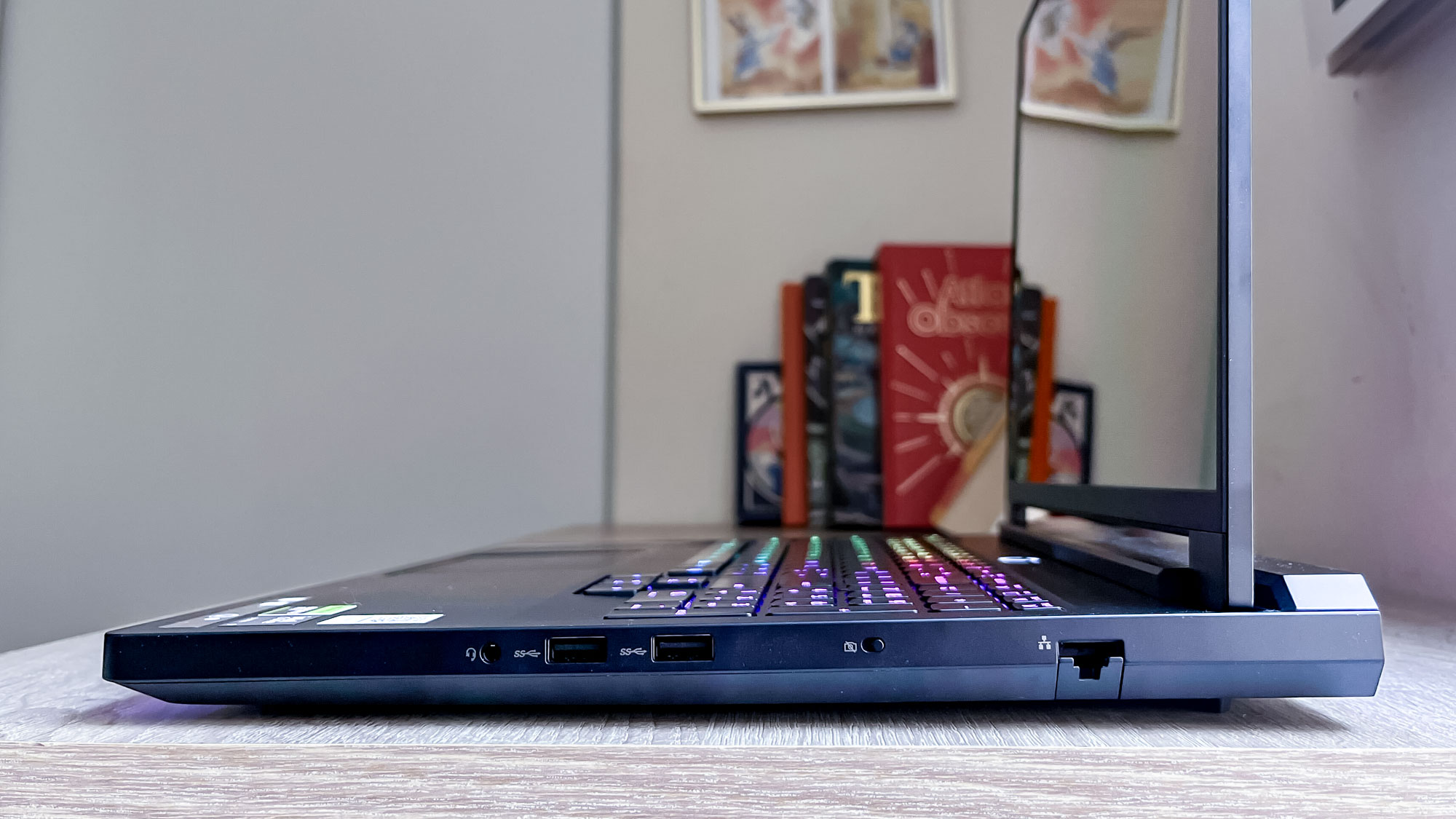
Look, port arrays aren't as exciting as gaming performance or gorgeous visuals, but they're critical to making full use of a good gaming laptop.
Happily, I'm here to report the 2025 Lenovo Legion Pro 7i has all the ports you could need for serious PC gaming. On the right side you get a pair of USB-A ports, the headphone jack, a webcam privacy switch and an RJ-45 Ethernet jack for wired gaming.
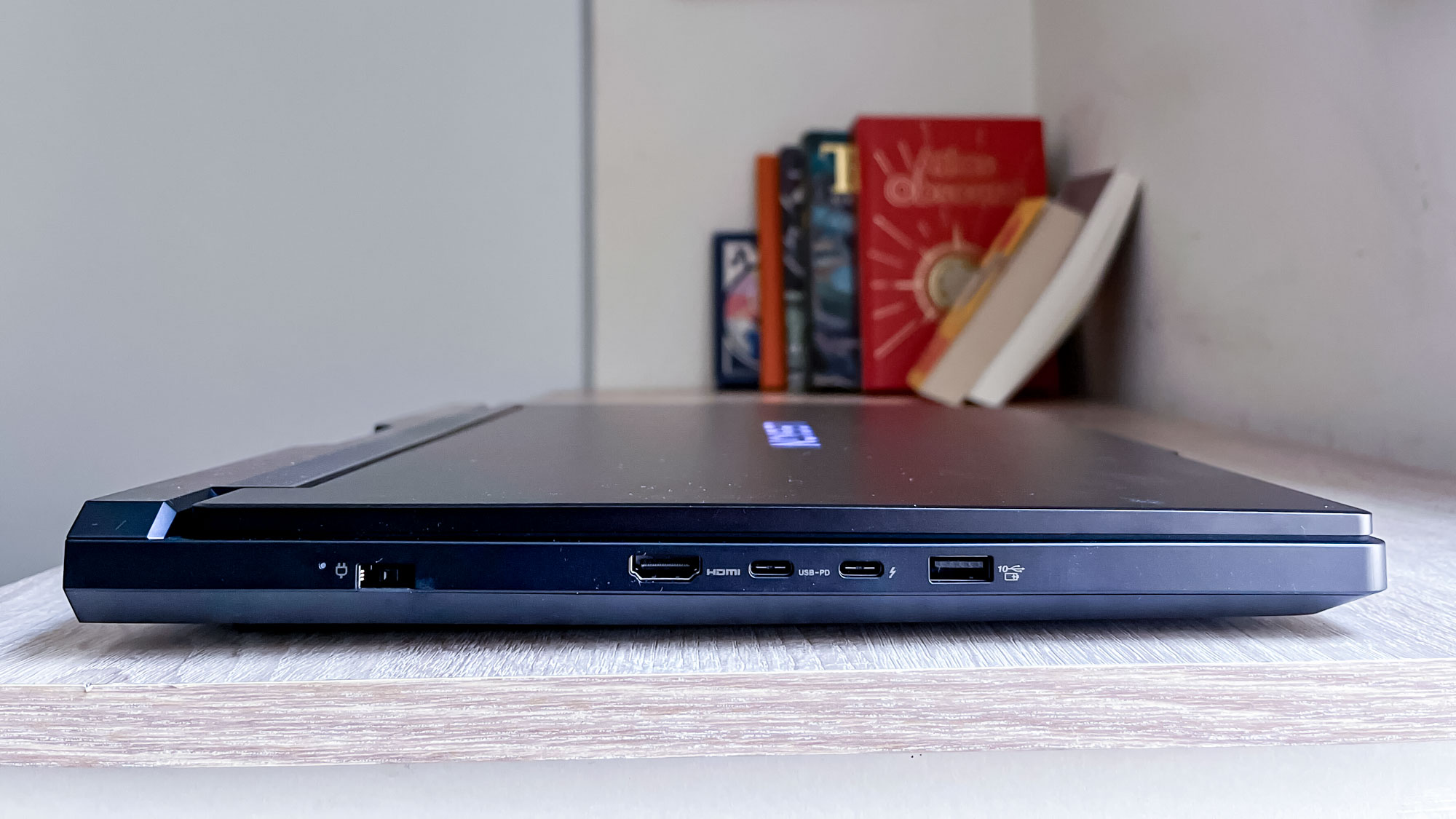
Meanwhile, on the left side you get a Thunderbolt 4 port, a USB-C port, another USB-A port, the HDMI 2.1 out and the power jack. You can also charge the laptop with a 65W-100W USB-C charger via the USB-C port if necessary.
These ports are situated a bit closer to you than they are on most laptops, but in practice I didn't feel like this staggered layout made anything harder or trickier to use.
Lenovo Legion Pro 7i review: The downs
As much as I've enjoyed my time with our Lenovo Legion Pro 7i review unit, there are some downsides you need to be aware of before you buy one yourself.
This beast is unusually hefty and pricey
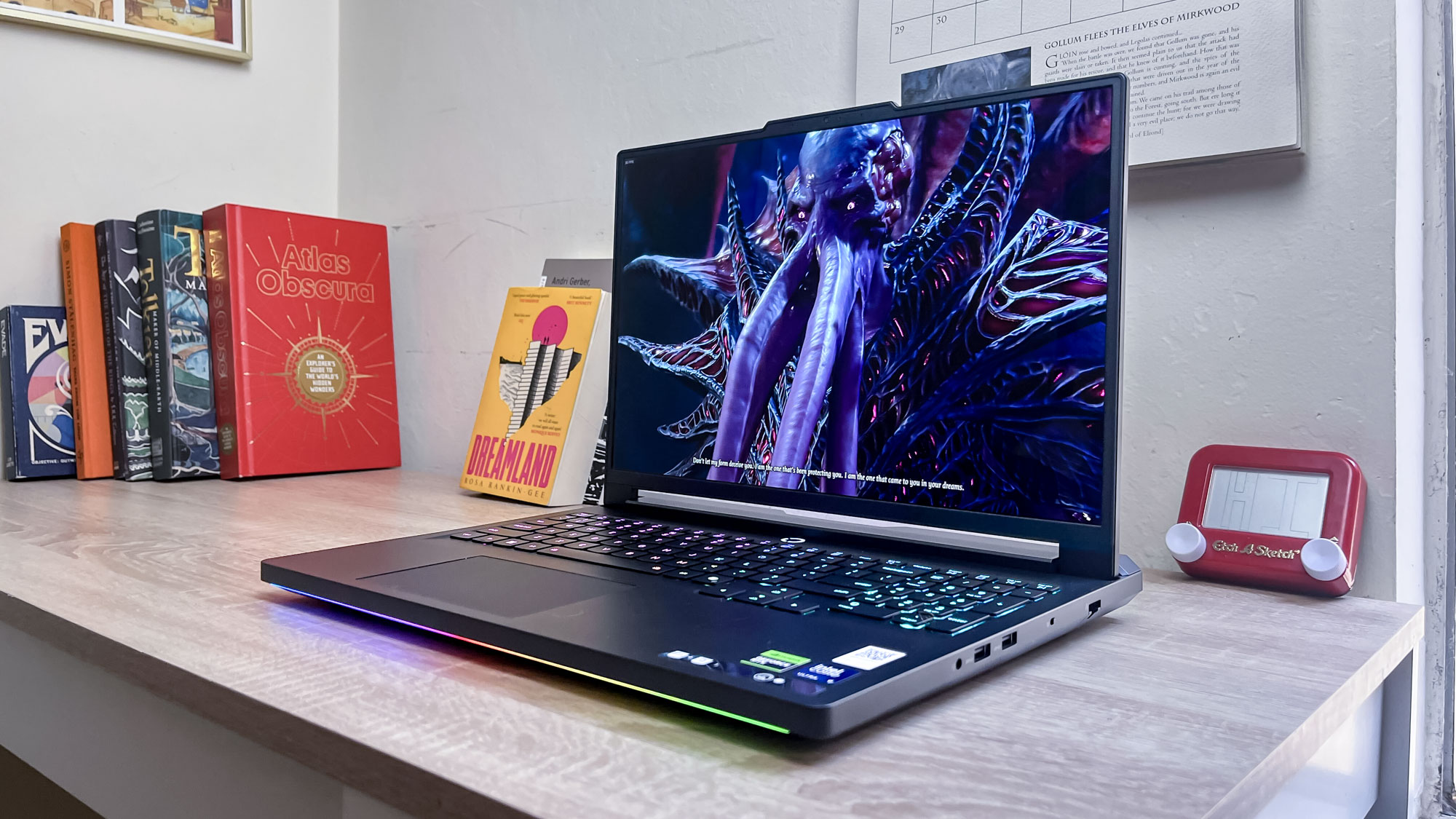
Amid all my general excitement over this 16-inch gaming laptop, I wanted to reinforce one big negative: it's a gaming laptop, with all the weaknesses common to that category of computer.
First and foremost, the nearly $3,000 starting price means you're paying as much or more for this laptop as you would for many desktop gaming PCs with more storage and upgradability. The Acer Predator Orion 5000 gaming desktop I reviewed last year, for example, costs half as much yet delivers better framerates in our tests despite having an older RTX 4070 Super Nvidia GPU onboard.
Plus, at nearly six pounds heavy this isn't a fun laptop to lug around in a backpack. While portability is one of its key advantages over a gaming PC, the fact remains that I kept this beast on my coffee table or my lap for the lion's share of my time with it. Every time I picked it up to move it I was impressed at how sturdy and svelte it feels, but I also felt like I wanted to put it down as soon as possible.
Fairly short battery life
Finally, like most gaming laptops, the battery life on the Lenovo Legion Pro 7i is low. In our testing it lasted roughly four and a half hours while surfing the web, and just over an hour and a half when running the PCMark10 gaming battery benchmark test to simulate the demands of PC gaming.
Laptop | Web surfing battery life (hh:mm) | Gaming battery life (hh:mm) |
|---|---|---|
Lenovo Legion Pro 7i (2025) | 4:37 | 1:36 |
Asus ROG Strix Scar 16 (2025) | 6:30 | 1:30 |
HP Omen Max 16 (2025) | 3:20 | 1:25 |
That lines up with my anecdotal experience playing games like Cyberpunk 2077 and Total War: Warhammer 3 on this laptop's battery, which barely lasted an hour in either game before the laptop was circling the drain at 10% battery and practically begging me to plug it in.
Now that's a bummer for me, but again it's par for the course with gaming laptops. And you can probably do a little better if you fine-tune the laptop's performance settings using the pre-installed Lenovo Vantage app, which — unlike the bloatware from some laptop vendors — has detailed and actually useful power profile controls, including a performance overclocking button you can only hit when the laptop is plugged in via its primary charger.
Lenovo Legion Pro 7i review: Verdict
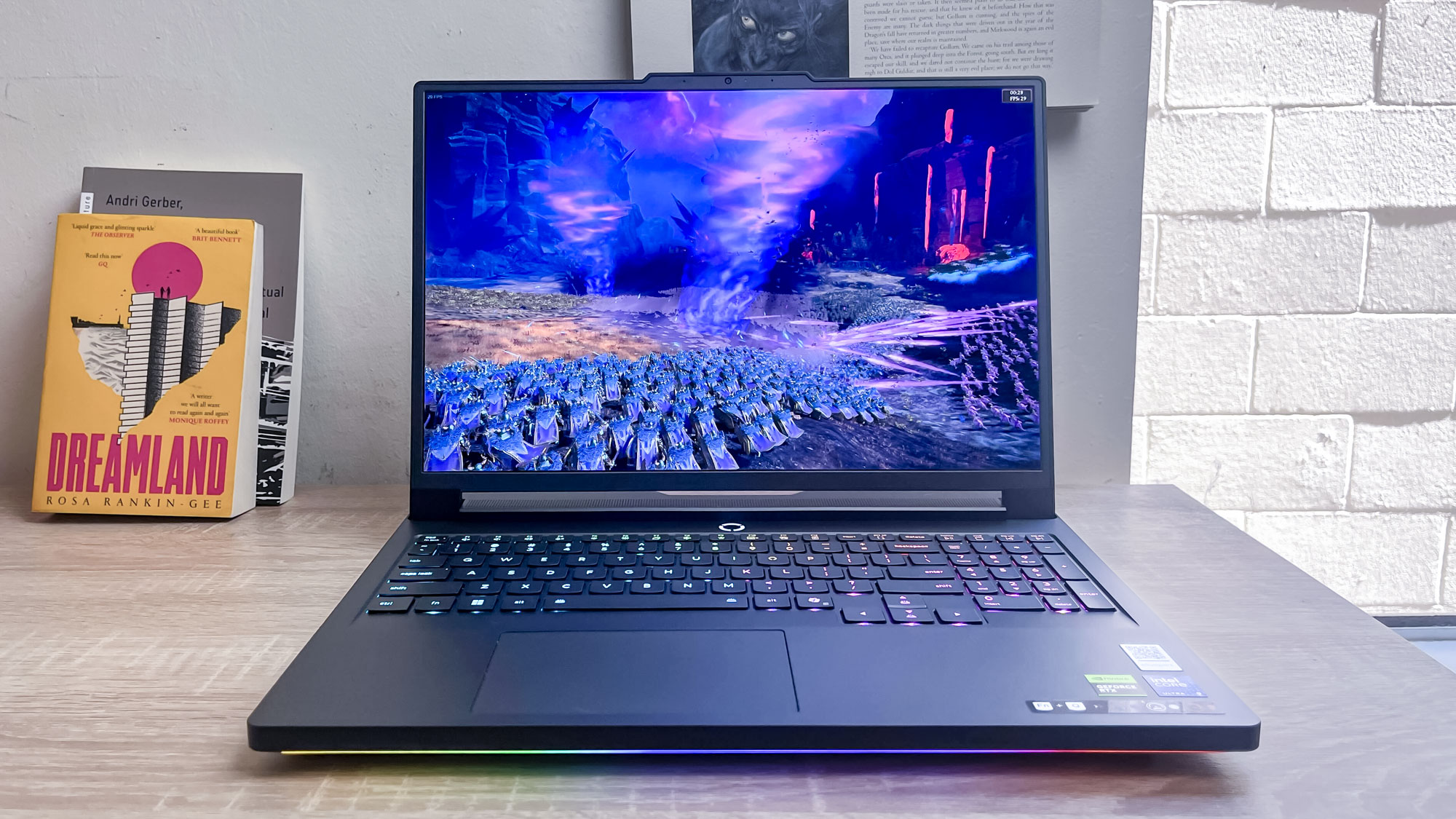
Overall, I adore the 2025 Lenovo Legion Pro 7i. If I was shopping for a gaming laptop for myself this would be a strong contender, though the high price would certainly be an issue.
But if you can stomach the price tag and don't mind the disadvantages of owning a gaming laptop, I think this is one of the best of the year so far. I've always loved gaming laptops for their power and portability even as I've bristled at their high price, poor battery life and hefty weights, so it's lovely to see Lenovo pushing the category forward by shipping such elegant, performant machines.
Sure, the 2025 Legion is still be no match for your average MacBook Air when it comes to portability and battery life, but the incredible OLED display and beefy internals of the 10th Gen Lenovo Legion Pro 7i help it appeal to more than just folks who want a good machine for PC gaming on the go.
Shucks, I daresay it might be one of the best laptops for video editing I've tested all year, thanks to its bright, color-accurate OLED display and discrete RTX 5080 GPU—though more RAM and storage would certainly help it stand out on that front.
Here's the bottom line: I've been using the 2025 Lenovo Legion Pro 7i as my de facto living room gaming machine for a week, and I've never been happier. Games run beautifully on this beast; it makes them look gorgeous on my 4K OLED TV; and I hardly hear a whisper of fan noise during even the most intense gaming sessions. In short, if money were no object, this is the gaming laptop I'd buy in 2025.

Alex Wawro is a lifelong tech and games enthusiast with more than a decade of experience covering both for outlets like Game Developer, Black Hat, and PC World magazine. A lifelong PC builder, he currently serves as a senior editor at Tom's Guide covering all things computing, from laptops and desktops to keyboards and mice.
You must confirm your public display name before commenting
Please logout and then login again, you will then be prompted to enter your display name.
